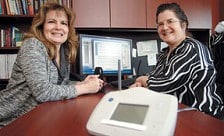Iowa Clinic speeds patients’ heart data to doctors

For recovering heart-failure patients, it’s especially important that their doctors maintain a keen eye on their progress.
The Iowa Clinic recently upgraded its remote patient monitoring system so that medical data is now instantaneously transferred from a device at the patient’s home into his or her electronic medical record. The new direct connection between patients’ homes and their electronic records is a first-in-the-nation innovation, clinic officials believe.
The speedier flow of information will enable Iowa Clinic cardiologists such as Dr. Pamela Nerheim to better monitor their patients, and keep more of them from being re-hospitalized.
“Heart failure is huge in this country now, and readmissions to the hospital to receive diuretics are high,” Nerheim said. “This is a simple way of getting information on the patient’s weight, activity level and blood pressure to the physician, so hopefully they can call the patient in early and avoid heart-failure hospitalization.”
Between 200 and 300 Iowa Clinic heart patients who have had implantable cardioverter defibrillators or pacemakers implanted are monitored by the system, called Latitude, which the clinic began using in 2006. Until recently, however, it wasn’t fully integrated into the clinic’s electronic medical record system. Now, the patients’ doctors can view the data immediately as it comes in, either on their computer or on their smart phone.
“Before, the information a lot of times would be on the desk, but maybe you didn’t get to the desk because you were at the hospital,” Nerheim said. “So to have it on something you can access from anywhere is hugely helpful. Being able to immediately respond to heart-failure patients is going to decrease their hospitalization.”
According to a December 2010 article in Circulation, the journal of the American Heart Association, a national study found that patients increased their survival chances by 50 percent by being remotely monitored, and patients whose blood pressure and weight were transmitted regularly fared even better.
“The presence of the remote communicator in the home, enabling the patient to initiate a transmission as well as engaging the patient by frequent queries related to heart-failure symptoms, can serve to involve the patient more fully in his or her health care,” the article said.
Boston Scientific Corp., which manufactures the defibrillators and the remote monitoring system used by The Iowa Clinic and by patients in the national study, estimates that 13,000 new patients are added monthly to the remote monitoring network, and that at any time, more than 350,000 patients are being monitored nationwide.
The Iowa Clinic may have taken the monitoring a step further than any other clinic in the country. When the clinic’s information technology staff looked into upgrading the system, they were told by Boston Scientific that no other clinic or software company they knew of had made the direct connection between remote monitors and patients’ electronic records.
“We write our own (software) interfaces, so the cost was minimal,” said Marilyn Backus, the clinic’s electronic medical records project manager. “We took very basic interfaced information, added the functionality of a PDF document viewer, and made it truly beneficial to the clinic.”
Using a scale and blood pressure cuff that connect to a small remote transmitter, patients are asked to weigh themselves and take their blood pressure reading each morning. That data, along with data transmitted wirelessly from the defibrillator implanted in their chest, is sent through their telephone line to the clinic to be updated in the patients’ records.
“It sends an indication of how active they are, based on information collected from their (defibrillator),” Nerheim said. “The report also indicates if they have a bad heart rhythm or if the defibrillator has had to give them a shock. It also tells us if there is a mechanical or electrical problem with the defibrillator or pacer.”
The system also saves patients from having to come in to the clinic as often. Previously, a patient might have to come in once a month if he or she was having problems, or a minimum of once every three months.
“This device collects information every day, so if there’s a problem, you’ll find it out within 24 hours,” Nerheim said.
The improved system represents a collaboration effort on the part of many people at the clinic, Nerheim said.
“It’s amazing what you can accomplish if you collaborate,” she said. “If everybody does what they’re good at, I think you do cost-effective, wonderful things.”











